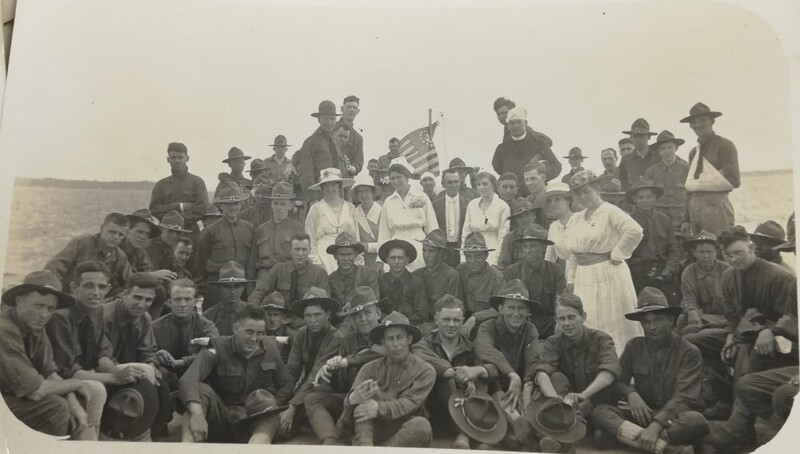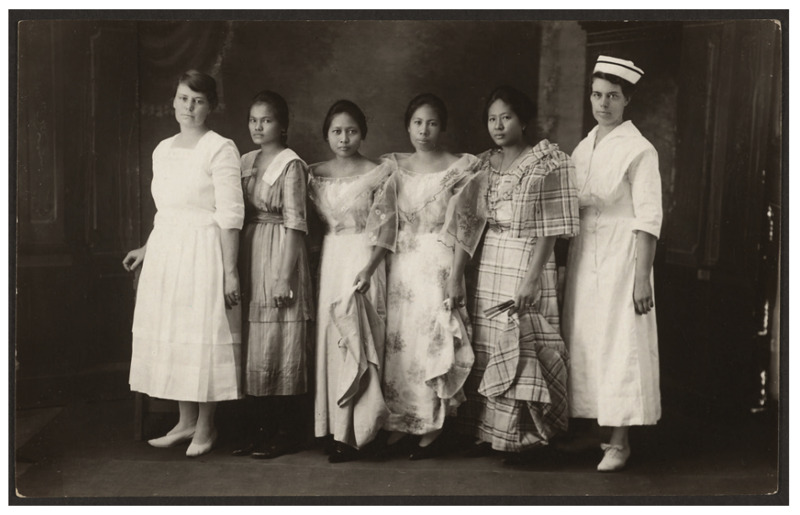Content Warning: This page contains descriptions of racist language and child abuse.
American Women in the Philippines
Centering the American Woman
In the image shown to the left, American nurses pose with a group of US soldiers in Baguio, Philippines.[1] There is a contrast between the women, who are dressed in white, and the US Army men in uniform. The women are standing at the center of the photo, drawing the viewer’s attention to their presence within the crowd of men. Notably, there are no guns in this photo and those pictured appear to be smiling. These details are not trivial but point to the powerful visual argument that Americans in the Philippines made in support of US imperialism.
In 1898, US President William McKinley referred to the American colonization of the Philippines as “benevolent assimilation.” Women, gendered as passive and less aggressive, became crucial to conceptualizing and representing this idea. To convince the American public, and the world, that US intentions were truly benevolent, the colonial government depended on the presence of white American women in the colony. Symbolizing innocence and femininity, white women in the Philippines were central (just as they are centered within this photo) to the discourse of US benevolence and goodwill. This photo, like many others contained within the archive, reveals how the bodies of women were used to maintain an image of peace and order as a result of US influence.
Gendering Violence and Mothering an Occupation
American women in the Philippines worked as missionaries, teachers, and nurses, but others accompanied their husbands as wives and mothers. Through their various roles in the islands, they enacted a “maternalist imperialism” which was first pioneered in the American West with the colonization of Native Americans.[2] Philippine natives, like Native Americans in previous historical contexts, became racialized as infantile and in need of the maternal guidance and care of the American woman.
This gendered argument helped to grant women more authority within imperial politics.[3] Some women played an active role, through their positions in the colony, in shaping public opinion. For example, the experiences of women in the colony allowed them to expand their visibility within the public sphere. Women used gender (femininity and the idea of women as maternal beings) to argue for their inclusion.
Yet even women who were not political shaped the gendered image of US imperialism through their writing.[4] Many women kept diaries documenting their travel and experiences in the islands. Journaling was a means for these women to document their personal experiences, but it also provided evidence in support of empire. Some women published their notes and observations, thereby shaping broader knowledge of the Philippines in allowing the American public to access their narratives.
Take the work of Emily Bronson Conger, who was the wife of Arthur Latham Conger, a US colonel. Emily Conger stayed in the Philippines even after the death of her husband. She published a book in 1904 entitled, An Ohio Woman in the Philippines.[5] Conger’s writing, while a subjective account, shaped the ways that Americans thought about Philippine peoples because most Americans lacked exposure to Philippine cultures. Her writing portrayed Filipinos as unsanitary, diseased, and unhappy. She wrote,
So many of the women are deformed and unclean, both the makers and the sellers that it seemed utterly incongruous that they should handle the most delicate materials… in our happy country we do not think of seeing a whole class of people diseased or maimed. In the Philippines one seldom sees a well-formed person; or if the form is good, the face is disfigured by small-pox.[6]
Conger wrote with heavy descriptions about her disgust of the Filipinos. Throughout the book, she expressed her urge to clean the “dirt[y], almost nude creatures” and dip them into “some cleansing cauldron.”[7] These descriptions echoed the writing of Michigan Men. She also wrote about the potential of Filipino women as limited to providing domestic services to white families. Conger argued that a Filipino woman would become “invaluable” only if she were able to hide her “dreadful looks” by dressing in western clothes and learning to prepare American food.[8]
Another prominent American woman in the Philippines who documented her journey was Nanon Fay Leas Worcester, the wife of Dean C. Worcester. She kept written accounts of her travels throughout the country with her husband, who served as Secretary of the Interior of the Philippine Islands. In her diary, Nanon Fay Worcester often distinguished native customs, dress, and behaviors from the American way. In one entry, she described her reaction to seeing native people (Bontoc, Samoqui, Talubin and Tacucan tribes) at a celebratory event:
When the night came and camp fires were lighted on all the atos [sic] and the people danced around them, the sight was weird enough but still more weird when we walked around the Plaza after dinner and found the people stretched out for the night on the ground or on the stones around the fire, not one in twenty with a stitch of covering except his “gee” string. One certainly gets used to the naked savage here. The majority of small children do not even bother with a “gee” string.” The men usually wear only the “gee” strings and the women a skirt that reaches from the waist to the knees and often opened up on one side. I wonder where else one could see so many beautifully formed and graceful people. They are like bronze statues.[9]
Worcester’s description of native people in the Philippines reflects colonialist tropes that associated nakedness with savagery. Her focus on clothing, and her fascination with the “gee” string, reveals how she imagined indigenous people as completely “weird” and different from herself. Worcester’s emphasis on difference echoed the rhetoric of the US government, of the Filipino need for American modernization. At the same time, she called them “beautifully formed,” which demonstrates her appreciation of the native people. Her description did not convey fear or regret, but an orientalist admiration of people she considered inferior. This statement supported colonialist rhetoric, as it highlighted the potential for Filipinos to learn from the US and eventually become modernized.
American Women also played a large role as missionaries in the Philippines. Mission trips were, according to the missionaries, meant to “modernize” the Filipino people as a part of the American objective of “benevolent assimilation” [10]. Such missionary work was seen as a site of cultural exchange, where American women could help shape Filipino ideals of womanhood and the modern state.[11]
Women who took on these positions were later able to expand into to the public sphere within the women’s movement in the United States, exposing their motivations for working in the Philippines. Using gendered issues, particularly the belief that Philippine women were immoral and in need of saving, female missionaries were able to better argue for their importance within the imperial project. Despite the fact that they were unable to vote until 1920, women’s participation in mission trips in the Philippines in the early twentieth century granted them greater authority in the public sphere.[12]
Sympathetic observers
It is not shocking to see colonialist tropes in the writing of women in the Philippines, especially in the accounts of administrators’ wives. However, there were also American women who used their privileged positions to critique US violence against the Filipinos.
Helen Calista Wilson, a white woman from Massachusetts, wrote extensively of her experiences in the Philippines. Her notes and observations were published in 1903 in the book, A Massachusettes Woman in the Philippines.[13] In particular, Wilson focused on Filipino suffering. She wrote about the violence committed by American teachers and soldiers in the Philippines. In one of her stories, she recalled the merciless whipping of a Filipino student by his American teacher. The student had not been attending class regularly and his teacher, Mr. Trace, was adamant about getting the student to attend class. So, according to Wilson, the teacher punished the student with twenty blows, and the student disappeared for a few days. Upon his return, Wilson explained,
Mr. Trace, bent upon maintaining discipline, repeated the beating, this time increasing the number of blows to thirty. The only result was to intensify the child’s aversion, and when he reappeared, after a still longer absence, Mr. Trace, now thoroughly exasperated, determined to make an end to the matter and whipped him once more, this time counting out fifty merciless blows on the little boy’s body. The little fellow shrieked with the pain, and the other children, thoroughly frightened, stopped their ears, shut their eyes, and wept with him.[14]
Wilson’s descriptions of American violence contradicted the claim of colonial administrators that Americans brought peace and benevolence to the Philippines. Wilson sympathized with the Filipinos and wrote about American violence in many of her other stories. In doing so, she formed a critique of US colonialism.
In general, Wilson’s politics differed greatly from other American women in the Philippines at the time. She was one of few Americans who attended the funeral of Apolinario Mabini, a Filipino revolutionary fighter and architect of the short-lived independent government. In her description of the funeral, she captured the Filipino perspective:
And there was something strangely and deeply impressive about the democratic simplicity of this great orderly silent gathering, rich and poor together following in the heat and dust of the street, and the strong of dark serious faces, so plainly stamped with the deeper melancholy of a long subject race, a sadness so deep that it seems to have grown into the very modelling of their features.[15]
Here, Wilson commented on the feelings that she perceived on the faces of Filipinos present who fought for their own freedom. She described what she saw as “strange,” but also “deeply impressive,” suggesting that she found such a sight to be unusual though not necessarily inferior. Her focus on the deep “sadness” of Filipinos humanized them, which defied dominant images of the Filipino as animal and object.
Nonetheless, American women promoted the imperial project through their very presence in the islands, even if they, as individuals, critiqued US violence and colonialism. The presence of American women in the Philippines was crucial to conceptualizing US imperialism and assimilation as benevolent. It also distinguished US empire from the Spanish. While seen as symbols of pacification, women’s involvement added a gender dynamic that redefined US-Philippine relations as tender and nurturing.
Citations
[1] Grace H. and James M. Miller papers, 1919-1938, Bentley Historical Library, University of Michigan.
[2] Laura R. Prieto, "Bibles, Baseball and Butterfly Sleeves: Filipina Women and American Protestant Missions, 1900–1930," in Hyaeweol Choi and Margaret Jolly, Divine Domesticities: Christian Paradoxes in Asia and the Pacific (Canberra, Australia: ANU Press, 2014), 371.
[3] Ibid.
[4] Nerissa Balce, Body Parts of Empire: Visual Abjection, Filipino Images, and the American Archive (Ann Arbor, MI: University of Michigan Press, 2016).
[5] Emily Bronson Conger, An Ohio Woman in the Philippines: Giving Personal Experiences and Descriptions Including Incidents of Honolulu, Ports in Japan and China (Akron Ohio: Press of R.H. Leighton, 1904), Special Collections Worcester Philippine History Collection, University of Michigan.
[6] Ibid, 60.
[7] Ibid, 51.
[8] Ibid.
[9] Nanon Fay Leas Worcester’s Diary, 1909, Bentley Historical Library, University of Michigan.
[10] Laura R. Prieto, "Bibles, Baseball and Butterfly Sleeves: Filipina Women and American Protestant Missions, 1900–1930," in Hyaeweol Choi and Margaret Jolly, Divine Domesticities: Christian Paradoxes in Asia and the Pacific (Canberra, Australia: ANU Press, 2014).
[11] Vicente L. Rafael, “Colonial Domesticity: White Women and United States Rule in the Philippines,” American Literature 67, no. 4 (December 1, 1995): 639–66.
[12] Laura R. Prieto, "Bibles, Baseball and Butterfly Sleeves: Filipina Women and American Protestant Missions, 1900–1930.”
[13] Fiske Warren, A Massachusetts Woman in the Philippines: Notes and Observations (Boston, MA: Press of J. J. Arakelyan, 1903).
[14] Ibid, 32.
[15] Ibid, 48.


